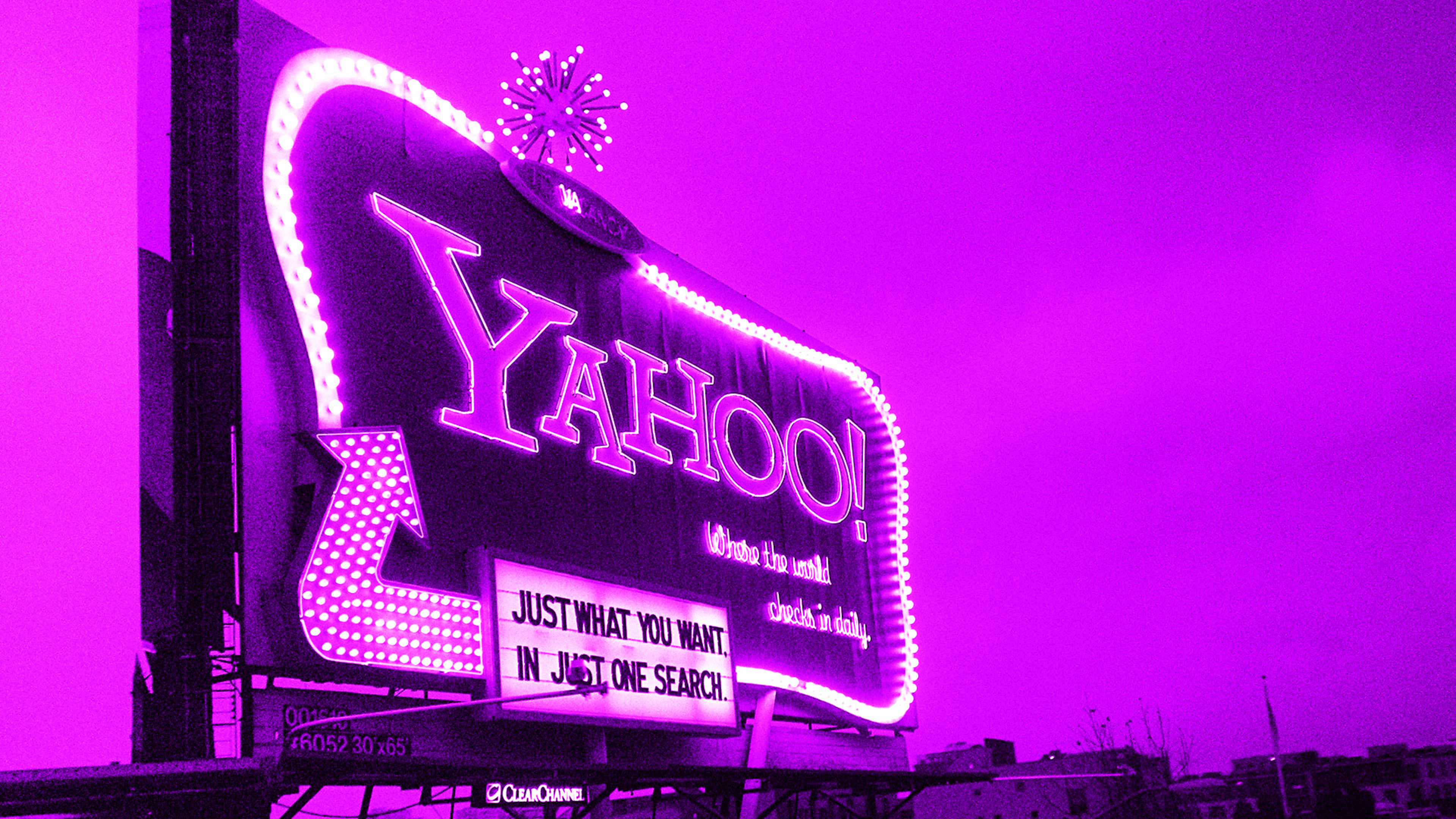Everyone knows how the story ends.
In July 2016, 22 years after it began as a hobby for Stanford graduate students Jerry Yang and David Filo, Yahoo agreed to sell its core operating business to Verizon in what Forbes writer Brian Solomon called “the saddest $5 billion deal in tech history.”
But few today recall how gloriously it began. Before Google or Facebook, Yahoo was the king of the internet.
Someone who does remember is Jeremy Ring, a top sales executive at Yahoo from 1996 to 2001. His recently published memoir, We Were Yahoo, details the improbable rise and precipitous fall of what was once the biggest internet company on the planet, worth $125 billion at its height.
“Our company was five years old,” Ring wrote. “We were worth more than Ford, Chrysler, and GM combined. Hell, we were worth more than Disney, Viacom, and News Corp combined. Each of those great American brands could have been swallowed up by us.”
It Started @ Yahoo: Yahoo Briefcase
Thanks to its entrepreneurial instincts and strategic acquisitions, Yahoo was well ahead of the curve in nearly every internet category. But it failed to capitalize on its early leads, leaving the field to be dominated by later entrants. Yahoo Briefcase, for instance, did cloud storage long before the likes of Dropbox, Box, and Google Drive.
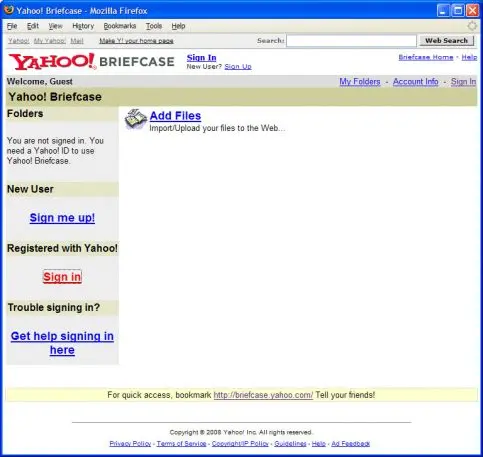
Portal Combat
For many in the 1990s, this spunky little startup with the funny name was the internet. It began life as a web directory, manually curated and categorized by humans, who were known simply as “the surfers.” Yahoo was the first site to add news, sports, and finance feeds to its web directory; those three services remain hugely popular as part of Oath, Verizon’s name for its AOL-Yahoo media mashup.
By early 1998, Yahoo had added email, shopping, classifieds, personals, games, travel, weather, maps, people search, celebrity chats, a kid-oriented version called Yahooligans, and an online magazine. At the time, it was competing with search portals like Excite, InfoSeek, and Lycos to provide everything on the net in one place.
“We didn’t want to call it a portal, because a portal is a door to somewhere else, and we wanted people to stay there,” says Shannon Brayton, a senior manager in Yahoo’s corporate communications department from 1998 to 2001.
Along the way, Yahoo broke new ground. Aside from being the first web directory, It was the first portal to offer localized directories for major cities, and the first to allow users to customize their own versions of the site, notes David Shen, Yahoo’s first designer, who later became VP of user experience and design. Shen published his own book about his nine years at Yahoo, Takeover! The Inside Story of the Yahoo Ad Revolution, last August.
Many of the apps and services we now take for granted were either invented at Yahoo or quickly found a home there. Before there was a YouTube, there was Broadcast.com, which turned into Yahoo TV. Before Instagram, there was Flickr. Before Evernote, there was Yahoo Notebook. Before Spotify, Yahoo Music. And on and on.
More important from a business standpoint, Yahoo pioneered the pay-per-click advertising model that soon became ubiquitous across the internet, notes Ring, who was working with Yahoo via an outside ad agency at the time. The first click-through banner on Yahoo was an ad for MCI; to ensure people clicked on it, Ring says, they embedded the word “naked” inside the ad copy.
It Started @ Yahoo: Yahoo Music
In 2001, Yahoo bought a startup called Launchcast and turned it into the basis of its own streaming music service. Before there was a Spotify or a Pandora, it pursued a freemium model: Listen to up to 1,000 songs a month for free, or pay $4 a month for CD quality, no ads, and unlimited skips.
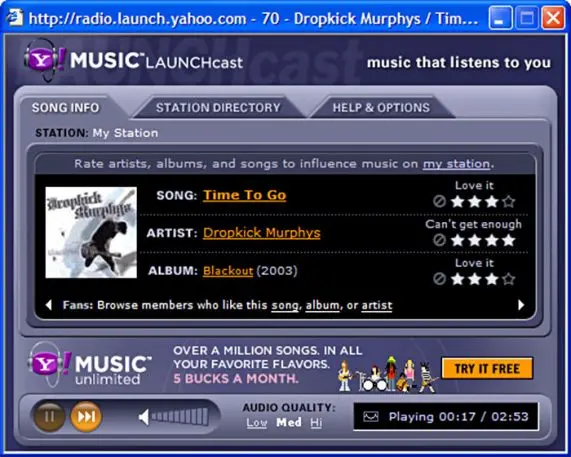
Yodeling For Dollars
And if Yahoo didn’t exactly invent Silicon Valley culture, it quickly became the poster child for it, says Tom Parker, who was at Yahoo from 1998 to 2004 as a copywriter and creative director.
“It was casual on a college level,” he says. “David Filo didn’t wear shoes. You could wear shorts and flip-flops to work. It was super entrepreneurial, which is now kind of a cliché.”
Early employees routinely slept at their desks after having spent all night writing code or updating content, says Ford Minton, senior art director from 1996 to 2001, who also held the informal title minister of culture.
Minton says Yahoos were known to wager on whether the company’s stock price would go up or down. One loser had his head shaved in front of the entire staff, others ended up at tattoo parlors to have the company logo permanently enshrined on their posteriors.
“It was very punk rock,” he says. “We were kind of making the technology up as we went. And things started getting crazy.”
To the public, Yahoo was the company with the funny TV ads and the famous yodel. It had personality in spades, which for technology companies in the ’90s was exceedingly rare.
“One of the things people don’t realize is that it’s those early TV spots that really made Yahoo an overnight global brand sensation,” says Parker. “It was that Do You Yahoo? tagline and that yodel. When I started in ’98, I’d go to parties, and people would see me and start yodeling.”
Black Rocket, a San Francisco-based ad agency, came up with the yodel for a series of TV spots starting in March 1996.
“When we launched Yahoo with a TV campaign on both coasts, there were at least 130 other search engines,” says John Yost, president of Black Rocket at the time. “But none of them had that cheeky name, and they were the first to get out there and advertise in a big and memorable way.”
For many, Yahoo and the yodel became synonymous. In November 2003, Yahoo set the Guinness World Record for Largest Simultaneous Yodel. In March 2015, on the 20th anniversary of Yahoo Inc., it broke that record.
“I’d get on an airplane in 1998, someone would ask me what I did, I’d say I work at Yahoo, and they’d go ‘ Ya-HOOO-ooo’,” says Brayton. “They really did that. Our CMO at the time, Karen Edwards, did an amazing job creating a brand with extremely high awareness. People wanted to know who this wacky company was.”
It Started @ Yahoo: Broadcast.com
Today, Broadcast.com is best known for the fact that Yahoo paid $5.9 billion for it in 1999, thereby turning internet entrepreneur Mark Cuban into internet billionaire Mark Cuban. Though the service didn’t go much of anywhere under Yahoo ownership, it’s recognizable as the proto-YouTube of the dial-up era.
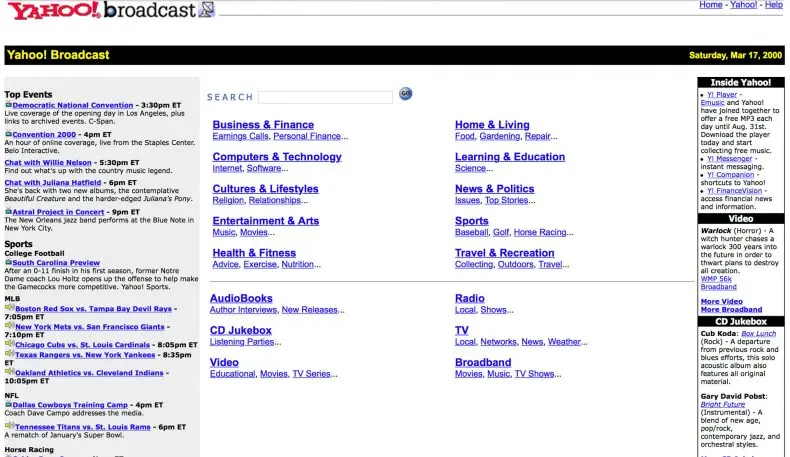
Missed It By That Much
The good times didn’t last. Yahoo lost many of its advertisers, and nearly all of its value, in the dotcom crash that began in April 2000. It never truly recovered. Now what people remember most are the missed opportunities.
In 1998, Yahoo had a chance to license an innovative new search technology created by a pair of Stanford grad students for $1 million. Instead, David Filo convinced Sergey Brin and Larry Page to strike out on their own, and introduced them to one of Google’s earliest investors, Michael Moritz of Sequoia Capital.
As Ring writes, “That $1 million price tag was probably the best deal offered in the history of Silicon Valley, California, the United States, planet Earth, and the Milky Way Galaxy.”
In 2002, Yahoo had a second chance to buy Google. This time, CEO Terry Semel offered $3 billion for the company; Page and Brin turned him down, reportedly holding out for $5 billion.
But even that’s not Yahoo’s most famous missed opportunity. That came in July 2006, when Yahoo tried to buy Facebook, then a college-oriented network with roughly 7 million members, for $1.1 billion. Internet lore has Mark Zuckerberg walking away from the deal when Semel cut the offer to $800 million after a drop in Yahoo’s share price. According to Peter Thiel, one of three members on Facebook’s board at the time, Zuckerberg never seriously considered selling.
Yahoo also had opportunities to acquire eBay and YouTube, and even entertained making an offer for Apple two years before the iPhone was unveiled, according to Gary Flake, principal scientist at Yahoo from 2003 to 2005. (The Apple idea didn’t get much traction, he adds.)
And Yahoo spurned offers—most famously when then CEO Jerry Yang aggressively rejected Microsoft’s attempts to buy Yahoo for $44.6 billion in 2008.
Rewriting history is always a tricky business. But given Yahoo’s less-than-stellar track record with large acquisitions–its $3.7 billion purchase of GeoCities, its $5.7 billion splurge for Broadcast.com, the $1.1 billion it dropped on Tumblr, none of which really amounted to much–it’s unlikely Google or Facebook would be the behemoths they are today if they’d become part of Yahoo.
“If you could suspend your disbelief and assume Yahoo would not have screwed up those acquisitions, it could have ended up being the most valuable company in the world,” says Flake. “Or, unbeknownst to everyone, it would have set the internet back a couple of years, because we’d lose Google and Facebook, and the world would have had to reinvent them.”
It Started @ Yahoo: GeoCities
Another 1999 acquisition, GeoCities let millions of people build their own websites, with results that were infectiously enthusiastic and famously ugly. Today’s Squarespace and WordPress let you build sites that are a thousand times more attractive, but the web lost some of its soul when Yahoo killed GeoCities in 2009.
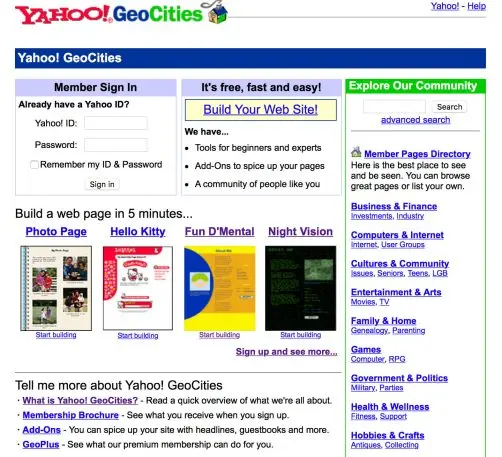
Failure Has Many Fathers
Everyone has a different theory as to why Yahoo failed, and to some degree they’re all probably right.
Ring says Yahoo’s biggest mistake was not allowing paid search ads to coexist with organic search results. For the first years of its existence, search results were considered editorial content, not to be sullied or diluted by advertising. By the time Yahoo realized its mistake–and acquired Overture, the company that invented paid search advertising, for $1.6 billion in 2003–Google was already steaming ahead.
Instead of fine-tuning Overture to compete with Google’s more sophisticated system, Yahoo decided to build its own advertising platform mostly from scratch, says Flake, who came to Yahoo as part of the Overture acquisition. Code-named Project Panama, the new platform took nearly three years to complete. By then, the search wars were over; Google had won.
But more than that, Yahoo never really decided what it wanted to be when it grew up. Was it a technology company? A search advertising platform? A burgeoning social network?
Its second CEO, Terry Semel, tried to turn Yahoo into a new media giant. Its eighth and final CEO, Marissa Mayer, wanted to transform it into a mobile technology company. Neither was willing to shed Yahoo’s legacy revenue-generating businesses, and both ultimately failed.
Trying to be everything to everyone was Yahoo’s downfall, says Parker.
“We were like Eratosthenes, whose nickname was Beta because he was second best at everything he tried,” he says. “That was Yahoo. We had a few core products like mail that were best in class, but most of our products were second best.”
Ring believes that with the right leadership Yahoo could have evolved into a combination of what Google, Facebook, and Netflix are today. But it lacked vision.
“Yahoo had a very narrow mind-set, which was, ‘We’re going to grab content, put it in front of our users, and call it a day’,” he says. “They owned the world, but they weren’t looking to the sky.”
It Started @ Yahoo: Flickr
Acquired by Yahoo a little over a year after its 2004 launch, Flickr was the first great way to share photos on the net. But after cofounders Caterina Fake and Stewart Butterfield departed, their brainchild languished, giving Instagram the opportunity to be the defining photo-sharing service of the mobile age.
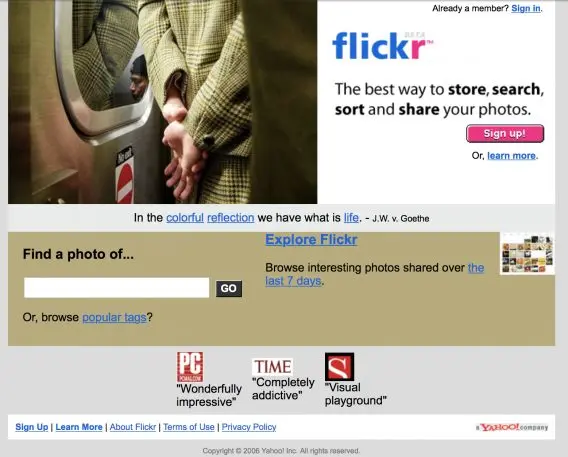
Purple Reign
Today, Yahoo’s DNA can be found all over Silicon Valley and beyond.
“You can’t go to any company in the valley and not find Yahoo’s imprint,” says Ring. “We come from the greatest alumni from any company in history.”
The list of startups launched by ex-Yahoos includes WhatsApp, Y Combinator, NextDoor, Slack, Cloudera, Bandcamp, and Polyvore (later acquired by Yahoo). Former Y! executives have filled up the C-suites at LinkedIn, Facebook, Google, Microsoft, Twitter, Airbnb, Dropbox, Etsy, IndieGogo, Kleiner Perkins, and Sequoia Capital, to name but a few.
You could even argue that Alibaba, China’s massive online marketplace, might not be a $160 billion company today without Yahoo’s $1 billion investment in 2005.
To this day, many ex-Yahoos say they still “bleed purple.” They continue to feel a deep connection to the Yahoo that was, along with a wistfulness for the Yahoo that could have been.
“The whole experience feels sacred to me,” says Mimi Lyons, one of the original surfers, who joined in November 1995 and stayed for seven years. “It’s something that just magically happened. We had the most amazing people at the right time in the right place. The memories of that, and the people, still matter to me.”
And that, perhaps, is something worth yodeling about.
Award-winning freelance writer Dan Tynan wore the Purple from 2013 to 2016. He’s still in recovery.
Recognize your brand’s excellence by applying to this year’s Brands That Matter Awards before the early-rate deadline, May 3.
